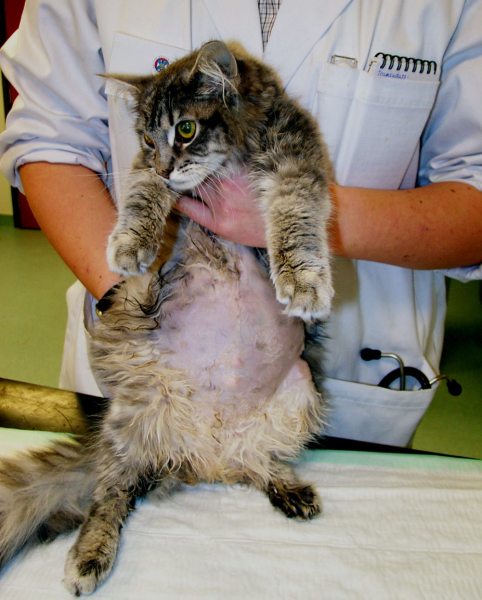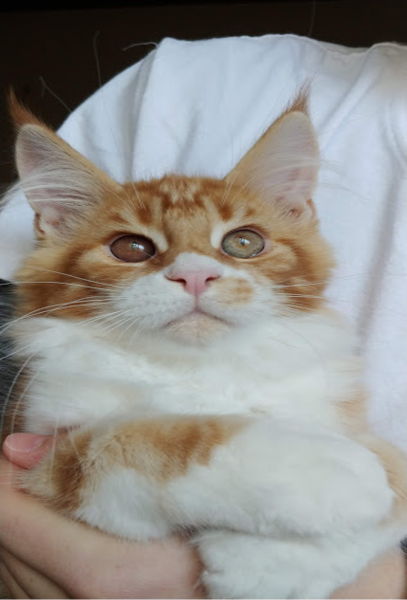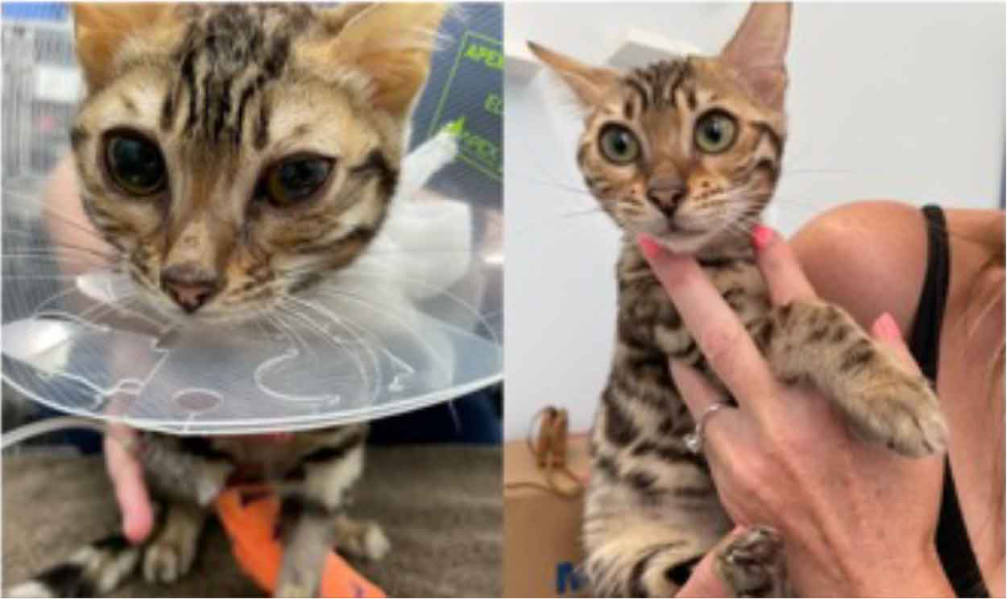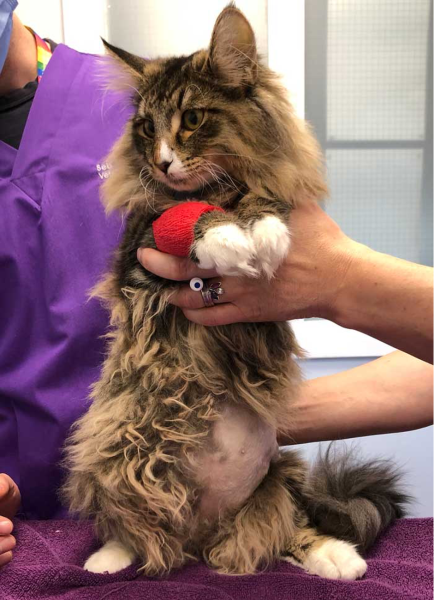There is hope for cats with FIP
Study into potential new tests for the diagnosis, management & prognosis of feline infectious peritonitis
Important notice
Unfortunately, we can no longer routinely offer FREE AGP. Please contact Rachael.hammond@ed.ac.uk to discuss if we can help. We can continue to offer therapeutic drug monitoring of GS-44/Remdesivir

Researchers at the Royal (Dick) School of Veterinary Studies (RDSVS), University of Edinburgh, are starting an important study to help in the diagnosis, treatment and prognosis of cats with FIP.
To help us do this, we are offering FREE serum AGP assessment & Therapeutic Drug Monitoring.
FIP is a challenging disease; it is difficult to diagnose and, until recently, was invariably fatal. COVID identified anti-viral compounds GS-441524 and its prodrug Remdesivir, and initial studies appear to show that they may be safe and remarkably effective, resolving up to 80% of cats with FIP after 12-weeks of treatment1. A definitive diagnosis is now ever more important.
 `
`  `
`  `
`  `
` 



Our study
We will:
- look at acute-phase protein (APP) profiles in blood and effusions. Preliminary data suggests that the APP a1Acid glycoprotein (AGP) usually increases in response to infection2, and typically decreases with effective treatment3.
- look at the role of micro-RNA (miRNA) profiles in blood and effusions; this pilot study may find a sensitive new test for the diagnosis of FIP and for monitoring its response to treatment.
- collect concurrent case histories and owner questionnaires to assess cat response and look for potential side effects.
- apply therapeutic drug monitoring (TDM) to see what serum/plasma concentrations are gained when treating these cats with GS-441524 (orally), and Remdesivir (by injection, eventually).
1. Assess APPs
We will assess up to 100 cats with potential FIP to identify at least 40 with ‘confirmed’ FIP for long-term follow-up while they undergo treatment. The cats need to have FIP ‘confirmed’ (either wet or dry forms) using the ABCD Algorithm http://www.abcdcatsvets.org/feline-infectious-peritonitis/.
Cats will be enrolled with the written informed consent of their owners, and their attending vets, who will be supported by the study clinicians. The cats will stay under the care of their own vets.
While the routine serum biochemistry and haematology are charged at their usual rate, the APP (i.e., AGP, Hp, and SAA) will be assessed; AGP will be free of charge and reported immediately. Hp and SAA (also free of charge) will be batched and analysed at a later date.
APPs will be assessed at Time zero (T0); increased AGP supports a diagnosis of FIP. Can the profile or individual APP concentrations be prognostic markers suggesting a likely response to antiviral treatment?
Ideally, each cat will also be assessed at Time point 1 (T1) at 12 weeks and T2 at 24 weeks.
T1 assesses response to treatment. AGP typically returns to normal following successful treatment3.
T2 assesses long-term response or relapse. Most relapses occur within a few weeks of T1. The outcomes at T2 may provide additional information about the usefulness of APP concentrations and/or profiles in the prognostication of the cats’ response to treatment.
The cats’ outcomes will be categorised as:
- Recovered
- Still undergoing Treatment
- Relapsed & on Repeated Treatment with a Higher Dose and/or additional drugs
- Relapsed & Euthanised
- No Response to treatment so Euthanised
- Other
2. Assess miRNA
This is a pilot study to evaluate whether specific miRNA or miRNA profiles may be useful in the diagnosis of FIP, and give valuable insight into the host's immune response to infection with FCoV. It will compare:
- serum from 7 cats with wet and 7 cats with dry FIP,
- serum from 7 cats with inflammatory disease, but not FIP,
- serum from 7 residual blood cross-match ‘cords’ from feline blood purchased for transfusions from The Banco de Sangue Animal.
This work could lead to sensitive and specific diagnostic assays and, potentially, treatments.
3. Case histories, clinical pathology reports & Owner questionnaires
For each of the time points (T0, T1 & T2), we will ask for the concurrent case history and clinical pathology reports, and ask the owner to complete a short questionnaire to see how well the cats are doing, and once the cats have started treatment, to find out about ease of administration, and the presence of potential side effects.
4. Blood concentrations of GS-441524
GS-441524 and its prodrug Remdesivir (GS-5734) have anti-viral activity including against FCoV and FIPV4. Both drugs have been ethically and legally formulated for animal treatment in the UK, and can be used to treat cats with FIP.
However, as yet, there is minimal data regarding the pharmacokinetics (PK) and pharmacodynamics (PD) of these compounds in cats with FIP, plus we do not know the therapeutic dose range, or effective plasma levels. The dose range used at present is based on a small number of data points and has not undergone objective PK clinical analysis. The collection of dose/plasma concentration data will allow a more rigorous analysis of the many variables found in FIP cases being treated with these drugs and hopefully lead to individual cats being treated with targeted drug regimens thus reducing stressors, cost, and likelihood of relapses.
Therapeutic drug monitoring (TDM) is the logical step short of PK/PD research. Only a small volume of blood is needed to determine the effectiveness of drug dosing in individual patients. TDM measures the concentration of the drug at a particular time after its administration, and can determine whether that value is within or outside the effective therapeutic range (for more information about this, please contact fipstudy@ed.ac.uk).
TDM of GS-441524 will be free of charge and reported immediately. Due to the variables affecting the manner in which anti-viral drugs are metabolised by ill cats, the levels obtained will be reported as either being ‘too low’ (below the effective in vitro value for preventing replication in 90% of virus particles – ED90), ‘close to effective value” (up to 5 x the ED90 value) or ‘high’ (greater than 5 x ED90). An estimation of the time the level of GS-441524 remains above the ED90 value between doses will be reported. This will indicate if the dose given is likely to maintain effective levels for the whole inter-dose interval (and thus reduce the possibility of drug resistance developing).
The results will be reported as cats likely to be receiving either ‘too little drug’ or ‘very much too much drug’. However, the effective dose range will only be confirmed once the results of this study have been analysed. A ‘rolling report’ indicating correlation between dose administered and plasma levels will be appended to TDM results as data is collected. This may aid responsible decision making; however, the test should not be used alone for clinical decision making until statistically useful numbers of cases have been analysed, and the method and results have been formally validated.
In the treatment of FIP with GS-441524 and Remdesivir, TDM may allow vets to consider adjusting doses to those most likely to provide effective virus inhibition whilst avoiding under- or over-dosage.
For cats needing high doses of GS-441524, TDM should differentiate cats that are virus resistant (i.e., the concentration of the drug is very high, in which case we need to change to a different treatment, if available), from cats that are cat resistant (i.e., the concentration of the drug is low because of enhanced metabolism, indicating the need to reduce dose intervals).
Please note: we can only assess blood from cats if they are being treated with legal drugs, not black-market forms of Remdesivir or GS-441524.
5. Study enrolment
Cats can only be enrolled in the study with the written informed consent of their owners. All cats will remain under the care of their GP veterinarian who will be supported by the study clinicians. Please ensure the FIP Study Owner Consent & Information Sheet (see below) is completed and returned with the blood sample and relevant submission form (EBP submission forms).
For routine testing (serum biochemistry and haematology; charged at their usual rate) ~3ml of blood is needed in these three tubes); filling them to the recommended 1.3ml will give us enough residual blood to test APP’s, miRNA, and TDM. We therefore need a minimum of 4ml of blood, ideally in the following tubes:
- 1 x 1.3 ml EDTA
- 1 x 1.3 ml plain
- 1 x 1.3 ml FlOx, plain or hep*
*But please do not waste blood in a FlOx tube; please assess the blood glucose concentration using a glucometer (preferably the Abbot one as this is more accurate and uses the smallest volume of blood), then write the blood glucose concentration of the form for us. If you happen to withdraw more than that, please do not waste it, send that too (in a plain or heparin tube), but cats must not be sampled or re-sampled (additional needle sticks) purely for the purposes of this study.
For TDM we need to know the current nature and dose of medication (e.g., 50mg GS-441524 given by mouth), weight of the cat (e.g., 5kg), when it was last given (e.g., 6am), and what time the blood was collected (e.g., 10am). Please submit all samples alongside the signed Owner Consent form and the appropriate submission form.
Participant Information Sheet & Consent Form
This study has ethical approval from R(D)SVS VERC and HERC committees.
Please send to:
FIP Study / R Hammond
- G.22 Clinical Pathology
- The Royal (Dick) School of Veterinary Studies and The Roslin Institute
Address
- Street
Easter Bush Veterinary Campus
- City
- Midlothian
- Post Code
- EH25 9RG
N.B. Unfortunately, we are unable to cover the cost of P&P, this allows us to pay for the AGP and TDM.
References
- Pedersen NC, et al. Efficacy and safety of the nucleoside analog GS-441524 for treatment of cats with naturally occurring feline infectious peritonitis. JFMS, 2019;21(4):271-281.
- Hazuchova K, Held S, Neiger R. Usefulness of acute phase proteins in differentiating between FIP and other diseases in cats with body cavity effusions. JFMS, 2017;19(8).
- FIPAdvice Team, Unpublished observations, 2022
- Murphy BG et al. The nucleoside analog GS-441524 strongly inhibits FIP virus in tissue culture and experimental cat infection studies. Vet Microbiol 219 (2018) 255-233.

